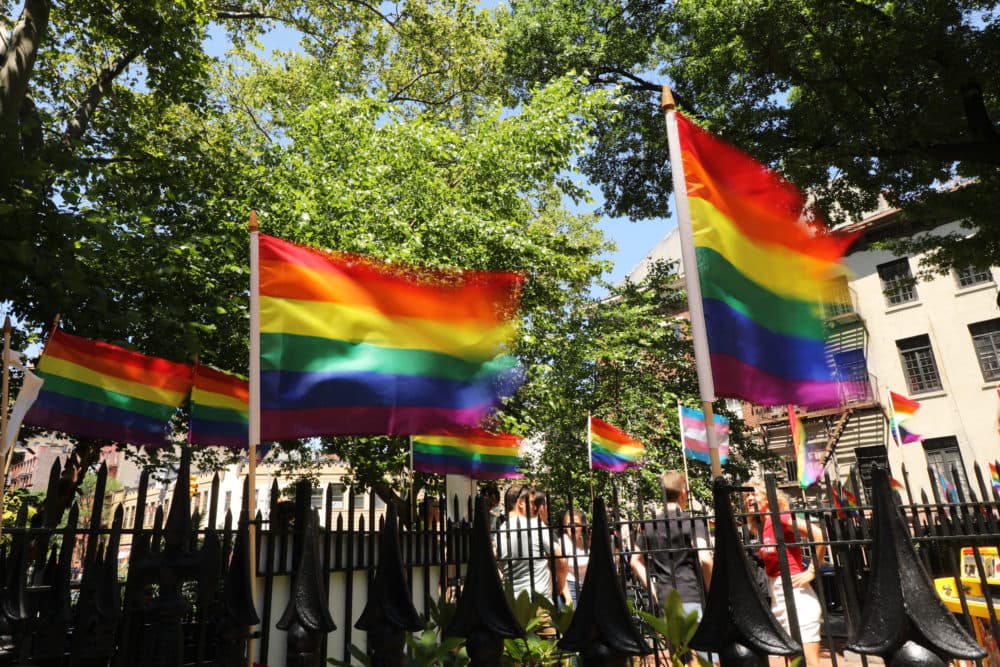Advertisement
50 Years After Stonewall Riots, Some LGBTQ Youth Still Struggle With Acceptance
Resume
The Stonewall Riots in New York City, which helped spark the LGBTQ rights movement, began 50 years ago on Friday.
And although there have been a number of social and legislative advances for lesbian, gay, bisexual, transgender, queer and questioning individuals, The Trevor Project’s CEO Amit Paley (@amitpaley) says there are “still a lot of challenges and a lot of work still left to do” to ensure full equality for LGBTQ people across the U.S.
The Trevor Project is focused on providing suicide prevention services to at-risk LGBTQ youth, while also conducting research into the field of suicidology.
In its most recent survey of LGBTQ youth mental health, nearly 40% of respondents said they have seriously considered attempting suicide in the past year.
Paley says that number is even higher for transgender or nonbinary youth. The survey found more than half of transgender and nonbinary youth have seriously considered suicide.
“Rejection and discrimination and hateful rhetoric” play a role in influencing suicidal ideation and attempts among LGBTQ young people, he says.
“There's also, especially in the past few years, been increasing hateful rhetoric happening from the highest levels of the U.S. government and political figures that ends up having an effect because words really do matter especially with young people,” he says.
Interview Highlights
On the biggest hurdles LGBTQ people have overcome since Stonewall
“Well there've been a number of advances for LGBTQ people, both on the legal and rights front as well as the cultural front. More Americans now say that they know someone who is LGBTQ than ever before. We see representations of LGBTQ people in the media and in the political realm. There's also been a number of advances on the legal front [such as] gay and lesbian and bisexual people have the right to marry someone of the same gender. There have been changes in laws around discrimination that have helped people on the state level in particular.”
On LGBTQ youth and suicide rates
“LGBTQ young people are more than four times more likely to attempt suicide than their peers. We just did a national survey on LGBTQ youth mental health which found that 39% of LGBTQ youth have seriously considered attempting suicide in the past 12 months and that amount is even higher for transgender and nonbinary youth. There are a number of different reasons why that's the case but some of the reasons are the rejection and the discrimination and hateful rhetoric that a lot of LGBTQ young people face every day in their communities — sometimes that's from their family or in their schools or their faith communities.”
On how issues of transgender youth differ from those of gay, lesbian and bisexual individuals
“Well there are even worse health outcomes for transgender and nonbinary youth than we see for gay, lesbian and bisexual youth. And part of that is because of the still increased discrimination and hostility and rejection that trans and nonbinary people face every day. And there's still a lot of people who do not understand what it means to be nonbinary.”
On what it means to be nonbinary
“There are many people who do not identify as male or female. They might identify as neither, as sometimes both, as sometimes alternating in between. … They might identify as nonbinary, they might identify as gender fluid, as gender queer, as agender. The actual number of labels and descriptions that people are using are very, very long — almost infinite. In fact, in this recent survey that we did, the young people that we surveyed [said] they had more than 100 different types of gender identities that they used to describe themselves.”
On whether social media have been helpful or harmful for LGBTQ youth in the U.S.
“It's been both. People will say things online, like, ‘You are an abomination,’ and, ‘You are disgusting.’ They will actually say [those] things to another human being. They will actually say to them, ‘You should go kill yourself,’ because of who you are, because you're a lesbian or because you're trans. But we also can see there are a lot of positive effects as well. For a lot of LGBTQ people, … they feel very alone. And so to be able to connect with someone online and [say,] ‘I feel different,’ and now this person that I see online is trans and I now have words and a role model and a person who is living their life in the way that I want to live it. That type of affirmation can be lifesaving for so many LGBTQ youth.”
On addressing suicide
“Part of that is making sure that they see affirming messages and that they get a sense that they should be proud of who they are. There's also a lot we need to do to stand up for the rights of all LGBTQ people who've had a lot of rights taken away from them. There are now many, many places in the country where if you're trans or non-binary young person, you are not allowed in a school to use the restroom that corresponds with your gender identity. That is wrong. That is un-American. That is unjust and we need to be fighting to stand up for the rights of all young people, especially LGBTQ youth who are most at risk.”
If you or someone you know is feeling hopeless or suicidal, contact The Trevor Project's TrevorLifeline 24/7 at 1-866-488-7386. Counseling is also available 24/7 via chat every day at TheTrevorProject.org/Help, or by texting 678-678.
If you or someone you know may be considering suicide, contact the National Suicide Prevention Lifeline at 1-800-273-8255 (En Español: 1-888-628-9454; deaf and hard of hearing: 1-800-799-4889) or the Crisis Text Line by texting HOME to 741741.
Ashley Locke edited and produced this segment for broadcast with Kathleen McKenna. Serena McMahon adapted it for the web.
This segment aired on June 28, 2019.
